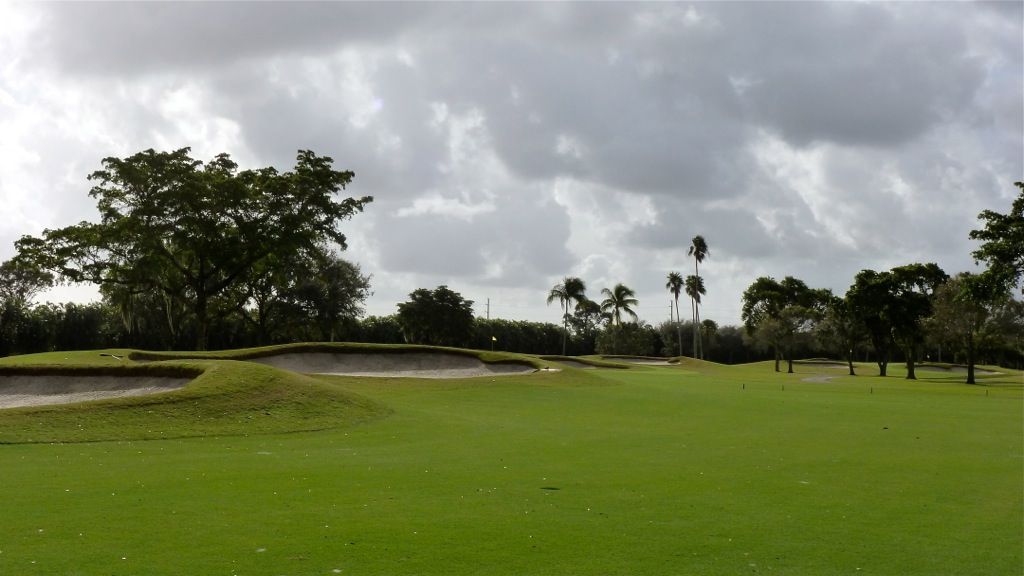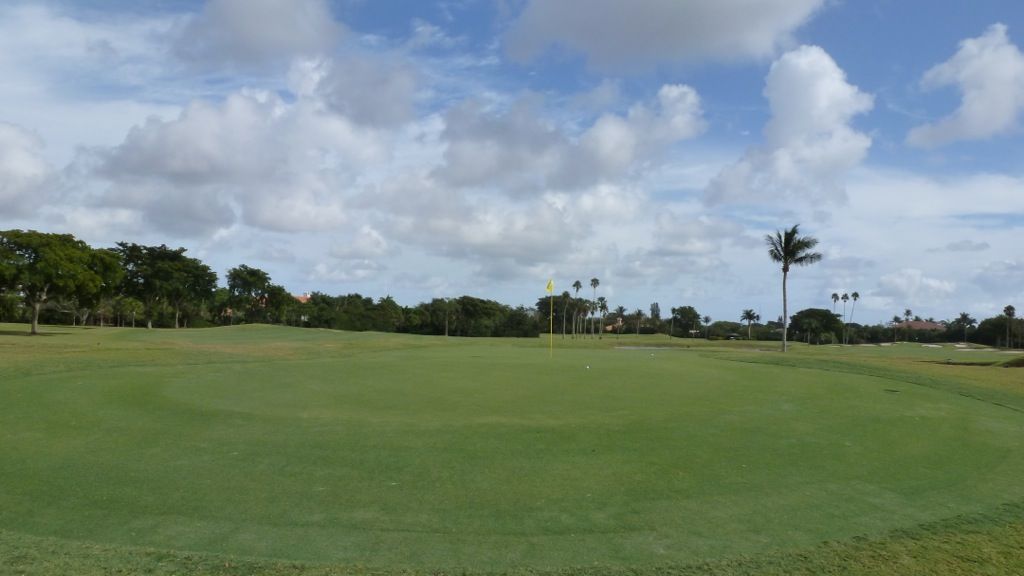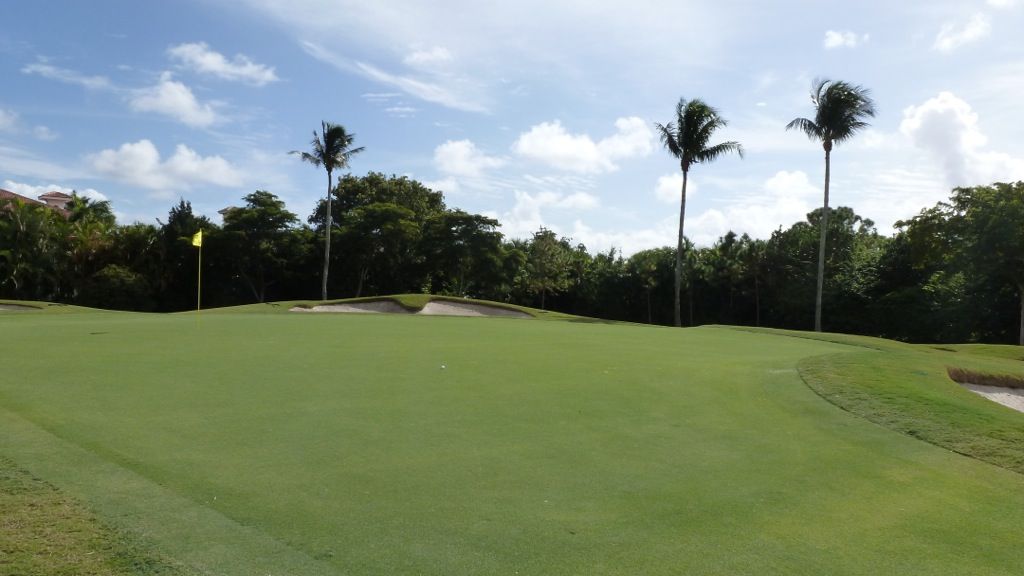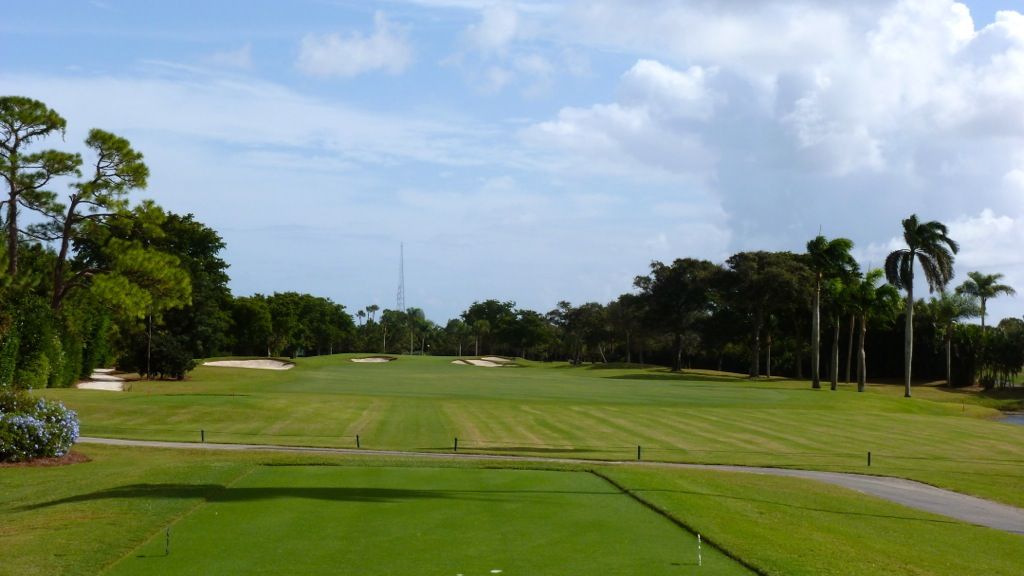Delray Beach, Florida, United States
Architect: Dick Wilson (1961)
7,315 Yards, Par-71
Rating/Slope: 75.3/137
My Quick Review: The best conditioned course in Florida.


Normal wind direction has holes 3/4 playing straight downwind...



I will post more later but wanted to get started...
First, as I said to Tony Nysse when I met him, "I didn't know greens in Florida could run this fast or putt this true." Though I was told that the greens were running slightly slower than mid-season speed (they were running at 12) and slightly softer that than mid-season firmness, I thought the maintenance meld was darned near ideal. Downhill putts/recoveries were fearsome but usually doable with a perfectly played shot. Well-struck approaches to greens would land and release a few yards, but shots hit a bit thin or fat would trundle over the green. When the greens are at full speed and firmness, combined with the wind, elevated greens, and run-offs at the perimeters of the greens, you better be one hell of a ball-striker to score.
I understand the fairways were all re-grassed in the summer with Celebration Bermuda. They are impeccable. The 6,600 yard tees I played actually played quite short, as unlike most Florida golf, shots hit in the fairway would bounce and roll-out.

A back pin must be the most difficult pin on the 1st green as the green slopes noticeable away once past its mid-point.

None of Wilson's par-3s are easy, but they do offer variety, playing in 3 directions and ranging from 137 to 190 yards (7i, 4i, 5i, PW for me). The 2nd green may be the most difficult par-3 green to hit, playing with a left-to-right wind and to a shallow green that falls off short, back-right and back-left.

3 and 4 are both mid-length par-4s, but downwind, length is not an issue on either. There is substantial fairway width at the 3rd, but pin position will dictate an ideal side of the fairway. As is regular at Pine Tree, the 3rd green is of a unique shape, narrow in the front half before widening significantly in the back-half -- almost like a 'T'.

The 3rd and 4th holes are interesting in that they are both holes that play straightaway, but because the golfer will aim away from the centreline of fairway, they feel like dogleg holes. At the 4th the Line of Instinct is interrupted by a rather large-scale bunker, but the golfer must fight his temptation to play left and play as far right as he dare for a much preferred angle of approach.

Approaches from the left are played over a series of greenside bunkers, one of which contains these grass islands, a feature seen several times on the golf course.

As seen from back-left, the 4th green lay at a 45-degree angle to the centre of the 4th fairway. Approaches from the right need not carry the greenside bunkering and run less risk of bounding into the swale beyond the green.

Along with the tee shot at the 12th (once also a par-5), the only bunkerless tee shot on the golf course. There is ample width, but the golfer, now having hit 4 shots in a row downwind, must immediately adjust his swing to the headwind. The picture below is taken some 230 yards from the member tee, leaving 330 yards to the green, an intimidating view and zero chance of clearing the fairway bunkers on the right. Cleverly varied fairway widths allow the golfer to play well short of the fairway bunkers, but the golfer wishing to leave 150 yards or less must bravely challenge the narrow portion of the fairway.

Though the 5th is a par-5, I am guessing few golfers will approach the green with less than a mid-iron third shot. The 5th features a fascinating green, whose back portion is split left and right by a spine that sends balls toward the fall-offs on the back corners of the green.

From the tee, the 6th looks strikingly similar to the 2nd. Removal of the fronting bunker, especially given the predominant wind direction, may allow for a greater variety of shots that could be played into this green.

The green is almost 3-pronged, with tongues/fall-offs front-left, back-left and back-right. Another mid-sized green that plays much smaller.

The seventh hole is the most difficult hole on the golf course and includes what must be the course's single most controversial feature -- a pair of trees guarding the ideal line within 50 yards of the tee. The prevailing wind is from right to left, demanding the golfer take their tee shot over the water to find the fairway. A pair of deep bunkers guard the outside of the dogleg -- they could be saving bunkers but their severity converts them to a penal feature.

Playing near the water leaves the much easier approach. Not only does the golfer play their approach on a straighter line into this angled green, but he also plays into its considerable slope.

The 8th is a similar hole to the 1st, playing in the same direction and moving left from the tee. Unlike the 1st, the series of bunkers on the left should not be challenged, and the angled green at 1st is replaced by a wide and shallow green.


The second of three par-5s on the golf course, the 9th is the only one reachable in two. A pair of bunkers intrude into the fairway's centreline and must be carried (about 230 yards from the Member Tee) if the golfer wishes to reach the green in two.

A series of 3 bunkers protect the right side of the fairway, and the closer the 2nd shot is played to the green, the narrower the fairway. Laying up to the widest point of the fairway leaves this imposing 100-yard approach...

While playing to the narrow left-side portion of the fairway leaves a more appealing pitch...

The 10th hole is a long par-4 (alternate tees allow this to be played as a par-5 on the Members Scorecard). Wilson showed more restraint with his fairway bunkering on the 10th with only a pair of shallow bunkers guarding the inside of the dogleg. Perfect mowing lines and fairway contouring combine to reward golfers that take the bold line.
Another angled green at the 10th. The shortest approach will always be from the left, but back/left pins are much easier accessed from the right.

Following the longest par-4 on the course, the 11th is the longest par-3 on the course, though this hole should be downwind. While the pair of par-3s on the front 9 were similar, the two on the back 9 could not be more different. The 11th features a massive green (the largest on the course?) and imposing bunkers on the right. Firm collars + the tilt of the green combine to repel shots that are bailed out away from the green. Misses left face a tricky pitch over a false-front.


The 12th is somewhat forgettable, but it once played as a (short?) par-5 and in that form the water 50 yards short of the green would have been a more interesting feature. The left-to-right wind makes the approach to the right-to-left angled green that much more challenging.

The 13th starts my favorite three-hole stretch at Pine Tree and Mike Nuzzo would be pleased to see the holes are routed in a triangle (sort of). Based on yardage alone, 13-15 looks like a great opportunity to score, but precision is demanded and small mistakes can result in bogey or worse.
The 13th is somewhat innocuous when the wind is down, especially when playing to a front-pin. But, the predominant wind direction plays across this hole from left-to-right and the lofted approach of a short-iron especially subject to its strength. What is not obvious from the tee is that the angled green stretches from 40 yards and at all distances is a shallow and elusive target.



The 14th is a reverse of the 7th though it plays much shorter. At both the 7th and 14th anti-strategic bunkering protect the outside of the dogleg and there is a significant reward for challenging the water.

Almost a replica of the 13th green, the 14th green is also long, shallow and angled from front-left to back-right. Approaches from the right side of the fairway, near the fairway bunkering, are near impossible when the hole plays down wind.


The 15th plays straightaway and straight into the wind.

The 15th green is similar to the 2nd and 6th greens in that it falls off in several places -- front-left, front-right...

Back-left and back:

The 16th begins the final 3-hole triangle, though no matter the wind direction these three holes make for an unrelenting finishing stretch. The 16th stretches to a devilish 666 yards and plays from a 100 yard long (?) runway tee.


While the 16th tee shot is demanding, bunkered on both sides of the fairway (and with a hidden stream waiting to catch those golfers that cut the left side too closely).

The second shot is a simple one, though perhaps this is fitting as few golfers will choose to hit less than 3-wood. The green is very large and gently contoured, falling off front-left and split down its centre by a subtle spine. Approaches from the right will be played over this Oakmontian bunker.

The 17th is straightaway and normally plays into the wind making it a real challenge. Even without the wind, a fascinating green will keep golfers interested.


Finally a hole where the predominant wind should assist with the playing of the hole. As at the 16th, the Line of Instinct is broken by a penal bunker, which should not be challenged. A tee shot aimed at the bunkering along the left side of the hole should be blown back to the centre of the fairway by the wind.

One final angled green -- one of the least contoured greens on the course -- awaits the golfer.


No comments:
Post a Comment